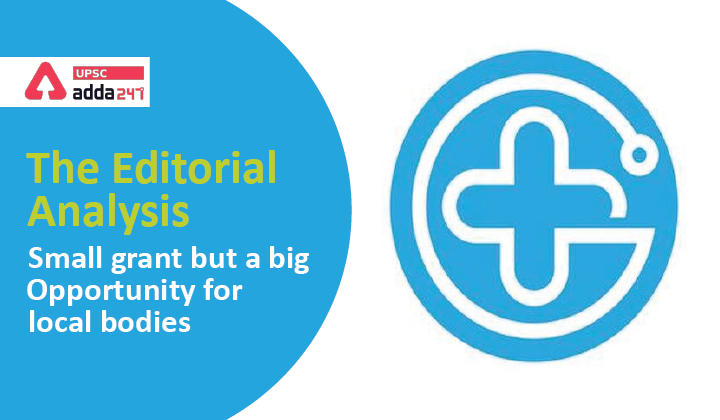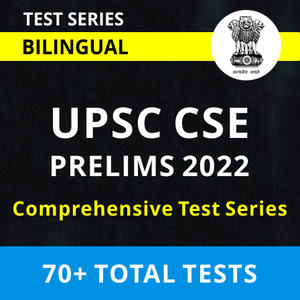Table of Contents
Small Grant but a Big Opportunity for Local Bodies- Relevance for UPSC Exam
- GS Paper 2: Federalism- Devolution of powers and finances up to local levels and challenges therein.
Small Grant but a Big Opportunity for Local Bodies- Context
- Recently, the Department of Expenditure released ₹8,453.92 crore to 19 States, as a health grant to rural and urban local bodies (ULBs).
Depletion of Groundwater Level: Steps by Government
Distribution of Health Grants to Local Bodies: 15th Finance Commission Recommendation
- Health Grants for FY2021-22 to FY2025-26: 15th Finance Commission (FC) made a recommendation for allocation of the health grant of ₹70,051 crore which is to be released over five years.
- Distribution: Of the total ₹13,192 crores to be allocated in FY 2021-22, rural local bodies (RLBs) and ULBs will receive ₹8,273 crores and ₹4,919 crores, respectively.
- Health Grant: for putting it in perspective, we have compared the grant with other health expenditures-
- As a % of total health expenditure: It would be 2.3% of the total health expenditure (both public and private spending together) of ₹5,66,644 crore in India.
- As a % of Annual government health expenditure: It would be 5.7% of the annual government health expenditure (Union and State combined) of nearly ₹2,31,104 crore (both figures for 2017-18).
- This grant is equal to 18.5% of the budget allocation of the Union Department of Health and Family Welfare for FY 2021-22 and
- It is around 55% of the second COVID-19 emergency response package announced in July 2021.
- Urban share is nearly five-fold that of the annual budget for the NUHM and rural allocation is one-and-a-half-fold that of the total health spending by RLBs in India.
73rd and 74th Constitutional Amendment Act- Key Challenges
- About: In 1992, as part of the 73rd and 74th Constitutional Amendments, the local bodies (LBs) in the rural (Panchayati raj institutions) and urban (corporations and councils) areas have transferred the responsibility to deliver primary care and public health services.
- Expectation:
- The creation of local bodies was expected to result in greater attention to and the allocation of funds for health services in the geographical jurisdiction of the local bodies.
- Alongside, the rural settings continued to receive funding for primary healthcare facilities under the ongoing national program.
- Reality: The government funding for urban primary health services was not channeled through the State Health Department and the ULBs did not make a commensurate increase in allocation for health.
- Reason: This is due to a resource crunch or a lack of clarity on responsibilities related to health services or completely different spending priorities.
- Poor Funding:
- In 2017-18, the ULBs and RLBs in India were contributing 1.3% and 1% of the annual total health expenditure in India.
- In urban settings, most local bodies were spending from less than 1% to around 3% of their annual budget on health, often lower than installation and repair of streetlights.
- Other issues in the health sector:
- Poor Urban Health Infrastructure: Urban India, with just half of the rural population, has just a sixth of primary health centers in comparison to rural areas.
- Urban primary healthcare services are weaker than what is available in rural India.
- Lack of coordination between a multitude of agencies that are responsible for different types of health services (by areas of their jurisdiction).
National Family Health Survey: Population Slowdown
Other steps taken by the government
- National Rural Health Mission (NRHM) 2005: It was launched to bolster the primary health-care system in India partly ameliorating the impact of RLBs not spending on health.
- However, urban residents were not equally fortunate.
- The National Urban Health Mission (NUHM) 2013: It was launched for the urban population with a budgetary allocation of ₹1,000 crores.
- Issue: Its budgetary allocation was just around 3% of budgetary allocation for the NRHM or ₹25 per urban resident against ₹4,297 per person per year health spending in India.
Boosting Health Infrastructure
Small Grant but a Big Opportunity for Local Bodies- Way Forward
- Generating Awareness:
- Among Local Bodies and Administrators: The grant should be used as an opportunity to sensitise key stakeholders in local bodies, on the role and responsibilities in the delivery of primary care and public health services.
- Awareness of citizens about the responsibilities of local bodies in health-care services should be raised. Such an approach can work as an empowering tool to enable accountability in the system.
- Role of Civil society organisations: They need to play a greater role in raising awareness about the role of LBs in health, and possibly in developing local dashboards (as a mechanism of accountability) to track the progress made in health initiatives.
- Increasing Health Spending: health grants should not be treated as a ‘replacement’ for health spending by the local bodies, which should alongside increase their own health spending regularly to make a meaningful impact.
- Mechanisms for better coordination: should be established among multiple agencies working in rural and urban areas should be institutionalized.
- Time-bound and coordinated action plans with measurable indicators and road maps need to be developed.
- Develop Innovative Health Models: The young administrators in charge of such RLBs and ULBs and the motivated councillors and Panchayati raj institution members need to develop innovative health models.
- Promoting and Funding Community Clinics: Before the novel coronavirus pandemic started, a number of State governments and cities had planned to open various types of community clinics in rural and urban areas. But this was derailed.
- The funding should be used to revive all these proposals.
The Editorial Analysis: Dynamism in India-U.S. ties
Small Grant but a Big Opportunity for Local Bodies- Conclusion
- The 15th FC health grant has the potential to create a health ecosystem that can serve as a much-awaited springboard to mainstream health in the work of rural and urban local bodies. The Indian health-care system must utilize this opportunity.
The Editorial Analysis- India needs a renewed health-care system
The Editorial Analysis- India needs a renewed health-care system




 TSPSC Group 1 Question Paper 2024, Downl...
TSPSC Group 1 Question Paper 2024, Downl...
 TSPSC Group 1 Answer key 2024 Out, Downl...
TSPSC Group 1 Answer key 2024 Out, Downl...
 UPSC Prelims 2024 Question Paper, Downlo...
UPSC Prelims 2024 Question Paper, Downlo...
